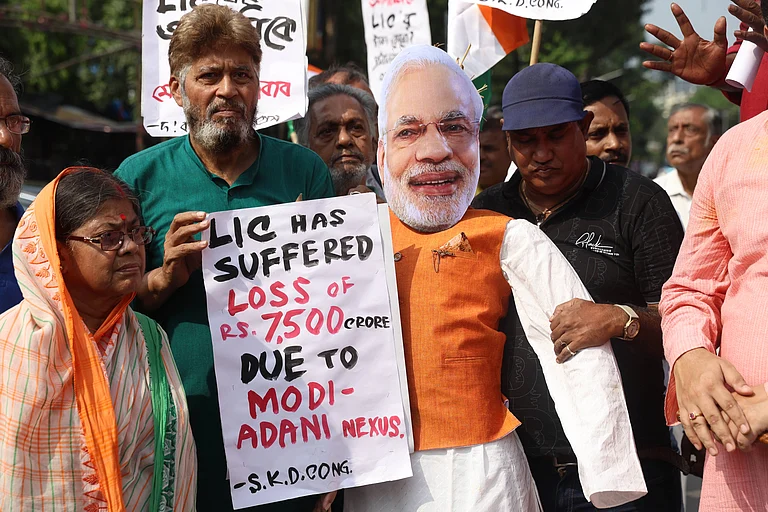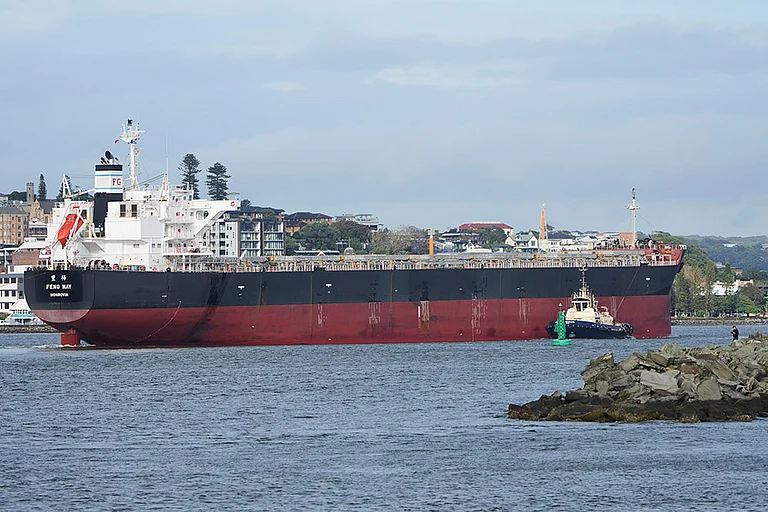
India’s shrimp industry is a pyramid. At the peak sit the exporters and processing companies with direct links to overseas buyers. Below them are pond owners, contractors, feed suppliers and traders
Gujarat’s farmers in Valsad and Surat face slashed prices, while Kerala’s peeling sheds—depending on raw shrimp from Andhra and Tamil Nadu—have gone eerily quiet.
The roots of the crisis lie in India’s dangerous dependence on the US. Over 35 per cent of Indian shrimp exports head there, making up nearly half of the country’s seafood export earnings.
At dawn in Amalapuram, in the heart of Andhra Pradesh’s Godavari delta, the peeling sheds usually hum with a strange music—the clatter of steel trays, the rustle of ice being crushed, and the quick, rhythmic movements of women’s hands as they strip shell after shell from heaps of shrimp. For years, this has been the soundscape of prosperity in a region that depended on paddy and coconuts before embracing aquaculture as its ticket to the global market.
Over the past few weeks, however, ice melts faster than the orders arrive and the sheds have fallen silent—a silence more menacing than the bustle to the rows of women who now sit idle, their gloves rolled up, waiting for consignments that never come. “Our women have nothing left to peel,” says Kovada Varalakshmi, president of the Andhra Pradesh Traditional Fishworkers Union. “This month, many will earn less than a quarter of their wages. Some of our children have already dropped tuition classes. The slowdown has cut our lives in half.” Weary and frustrated, her voice carries over to the courtyard where workers have gathered.
This Amalapuram scene repeats itself across the heart of Andhra’s aquaculture belt, which also includes Kallakuru, Kallavapudi and Bhimavaram. Ponds brimming with Litopenaeus vannamei, the exotic white-leg shrimp that has turned India into a global seafood powerhouse, remain unharvested. Containers meant for supermarkets in New York and Texas stand sealed in the cold storage yards of Visakhapatnam, their contents frozen not just by ice but by trade politics thousands of kilometres away.
The shock came from Washington, where the Donald Trump administration imposed steep tariffs of 20-25 per cent on Indian marine exports. The impact was immediate and devastating for Andhra, the region responsible for producing the majority of India’s shrimp. Forward contracts froze. Midstream payments ceased. Banks tightened credit lines. Women living on piece-rate wages in the delta villages suddenly found themselves staring at unstocked kitchens.
India’s shrimp industry is a pyramid. At the peak sit the exporters and processing companies with direct links to overseas buyers. Below them are pond owners, contractors, feed suppliers and traders. At its very base—the foundation, yet also the most fragile—are thousands of women workers, many of them Dalits or migrants from Odisha, Bengal and Bihar. They peel shrimp until their fingers are raw and numb, and are often paid per kg, with deductions for gloves, transport and food. When exports stall, they are the first to lose wages. “The ponds are full, yet there is hunger in the villages,” Varalakshmi says, summing up the cruel paradox.
The ripple has not stopped at Andhra’s borders. In West Bengal’s Purba Medinipur and the Sundarbans, ponds heavy with Banglar chingri (Bengali shrimp) remain unharvested as American buyers pull out or demand impossible discounts. Exporters in Digha say they are testing European markets, but shifting overnight is not easy—new markets demand different quality norms, certifications and relationships. In Odisha, the Balasore-Bhadrak belt, which shipped seafood worth $170 million to the US last year, has seen a third of its market evaporate. Paradip’s processing plants are operating at only a fraction of their full capacity. In Tamil Nadu, pond owners in Nagapattinam and Cuddalore are delaying harvests, while processors in Ramanathapuram and Thoothukudi cut procurement and scramble for alternative buyers in the Middle East. Gujarat’s farmers in Valsad and Surat face slashed prices, while Kerala’s peeling sheds—depending on raw shrimp from Andhra and Tamil Nadu—have gone eerily quiet.
Altogether, shrimp worth nearly Rs 25,000 crore is stuck in ponds and cold storage. The Seafood Exporters Association of India (SEAI) has rushed to seek emergency relief in the form of soft loans, credit extensions and interest subvention. But everyone knows such measures will only ease the cash crunch; diversifying into new markets takes years, not months.
The roots of the crisis lie in India’s dangerous dependence on the US. Over 35 per cent of Indian shrimp exports head there, making up nearly half of the country’s seafood export earnings. Last year alone, more than 2.6 lakh tonnes crossed the Pacific. The industry’s rise rests largely on vannamei, the exotic shrimp introduced in the late 2000s as a high-yield alternative to the black tiger shrimp. In little more than a decade, vannamei displaced traditional varieties and turned the coast into a monoculture economy—one that looks strong in prosperous years but buckles at the first jolt.
The roots of the crisis lie in India’s dangerous dependence on the US. Over 35 per cent of Indian shrimp exports head there.
“India holds 35 per cent of the US shrimp market, yet our exporters are crippled by cumulative duties that now touch nearly 60 per cent, while Ecuador, Vietnam and Thailand face only 10-20 per cent,” says the SEAI secretary-general K. N. Raghavan. A former Indian Revenue Service officer who now speaks for the industry, Raghavan argues that the way forward lies in integration—farmers and processors working together, value addition at home rather than raw exports, and a strong push for diversification. “Without these, we are staring at an existential crisis,” he warns.
Prices on the ground confirm the slide. Before the tariffs, small-sized vannamei fetched around Rs 290 per kg. Now, farmers struggle to sell at Rs 220–230. Larger shrimp that once commanded Rs 380 barely fetch Rs 310. With feed and power costs rising, pond owners say their operations are no longer viable.
For women workers, however, the crisis is not about market share or balance sheets. It is about survival. In the sheds, their exploitation has always been hidden: pregnancy tests before hiring, dismissals when a worker begins to show signs of pregnancy, denial of lighter duties, cramped dormitories with curfews for migrant women, and worse. Paid on a piece-rate system, they endure long hours without overtime. They lose everything when orders disappear, including wages, savings and social security. “The sheds shutting down means empty kitchens,” says Chennai-based researcher Sreedhar Raghavan. “A tariff hike in America translates into mothers going hungry here. What we see today is a betrayal of people’s food rights—fish are no longer valued as nutrition for our communities but reduced to mere export commodities. And the aquaculture boom in Andhra Pradesh and Tamil Nadu has devastated fragile ecosystems, leaving behind poisoned soils and collapsing livelihoods in the name of profit.”
The environmental reckoning is just as harsh. In the rush to embrace vannamei, entire stretches of coastline lost their mangroves, the natural nurseries and storm buffers that protected communities. Effluents laced with antibiotics seep into rivers, while salinisation ruins paddy fields. “The ecological bill is yet to be paid,” warns coastal rights activist S. P. Udayakumar. Varalakshmi puts it more bluntly: “We lost our creeks and mangroves. Now we have poisoned ponds. They said shrimp exports bring dollars, but those dollars never reach us.”
The Andhra government, aware of the storm gathering in its delta, has hurriedly formed a 16-member panel of exporters, feed producers and officials to study Ecuador’s model and scout new markets. The stakes are high: the Godavari region alone produces four lakh tonnes of shrimp annually, of which 3.5 lakh are meant for export.
Exporters, however, admit the danger is not new. Alex Ninan, an exporter based in Kochi, says the new tariff has put them in a dire situation. “Importers have asked us to hold shipments of pending contracts. Banks are reluctant to extend their working capital limits, as they anticipate potential negative consequences. Fishermen find it unviable to fish, farmers can’t farm, and opposition to aquaculture is growing,” he adds.
In Kanyakumari, Gandhi Varadaraj of Jude Foods notes that US buyers began scaling down long before the tariffs, leaving exporters scrambling to Europe and Asia. Kerala exporter Shaji Mathew is sharper still: “Once US buyers switch, they rarely return.”
The American appetite is not confined to shrimp. Smaller consignments of ribbonfish, croaker, squid, cuttlefish and surimi-based products also make their way to the US. Yet these remain sideshows; shrimp alone anchors India’s seafood fortunes.
This fragile dependence is hardly new. Until the mid-2000s, it was wild-caught shrimp that dominated India’s exports to the US. That trade collapsed when Washington barred imports from countries that refused to adopt Turtle Excluder Devices (TEDs)—metal grids with escape hatches fitted inside trawl nets that allow endangered sea turtles to swim free while retaining the shrimp catch. The US made TEDs mandatory as far back as 1987 after studies revealed industrial shrimp trawlers were killing tens of thousands of turtles each year. Many countries complied. India resisted, citing high costs and technical impracticalities. The fallout was immediate: wild shrimp exports to the US were shut out, and the industry pivoted almost entirely to farmed vannamei.
Today, from Bengal’s tidal flats to Odisha’s estuaries, from Andhra’s delta to Tamil Nadu’s export hubs and Gujarat’s saline creeks, the same story plays out: ponds full of shrimp, cold stores full of stock and families with empty wallets. A decision made in Washington ripples through the backwaters of Kakinada and the slums of Bhimavaram, reshaping lives that never voted for Trump.
For an American diner, shrimp serves as a cost-effective luxury item. For India’s coast, it is a fragile lifeline. Each prawn carries the weight of numbed fingers in peeling sheds, vanished mangroves, mounting farmer debt, and the reminder that the fate of millions can turn on the stroke of a pen signed half a world away.
MORE FROM THIS ISSUE
K. A. Shaji is Senior Assistant Editor, Outlook
This September 1, 2025, issue 'The Tariff Weapon’ of Outlook Magazine arrives at a critical moment in India’s economic story. With President Donald Trump announcing that tariffs on Indian exports to the United States will rise to 50 per cent. It appeared in print as 'That Sinking Feeling'





















.jpg?auto=format%2Ccompress&fit=max&format=webp&w=376&dpr=2.0)













